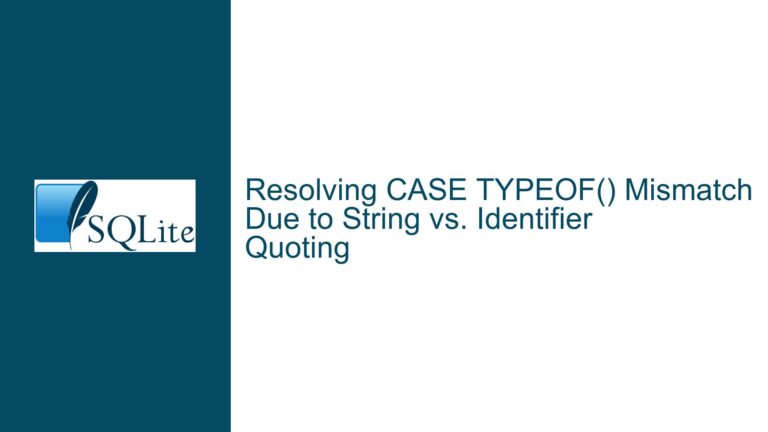Potential Bugs in SQLite Queries Involving GROUP BY and HAVING Clauses
Issue Overview: Unexpected Query Results Due to Ambiguous GROUP BY and HAVING Usage
The core issue revolves around SQLite queries that produce unexpected or inconsistent results when using the GROUP BY and HAVING clauses. Specifically, the queries involve multiple tables, views, and complex conditions that lead to ambiguous or incorrect results. The problem manifests in three distinct test cases, each highlighting different aspects of the issue.
In Test Case 1, the query involves a GROUP BY clause with a HAVING condition that references a column not included in the GROUP BY clause. This leads to unexpected results when the query is executed, as the HAVING clause operates on an ungrouped column. The query also involves a UNION ALL operation, which further complicates the result set, as the individual SELECT statements within the UNION ALL produce different results despite being logically equivalent.
Test Case 2 exhibits a similar issue, where the GROUP BY clause groups rows based on specific columns, but the HAVING clause references a column (t0.c2) that is not part of the GROUP BY clause. This results in ambiguous behavior, as the HAVING clause can evaluate to either TRUE or FALSE depending on which row’s value is chosen from the group. The query also includes a UNION ALL operation, which compounds the ambiguity by combining results from multiple SELECT statements with different HAVING conditions.
Test Case 3 introduces additional complexity by involving a VIEW, INNER JOIN, and a WHERE clause with collation and string manipulation functions. The query results differ depending on whether an aggregate function (SUM) is used, suggesting that the query planner or execution engine may be handling the GROUP BY and HAVING clauses inconsistently. The use of collation and string functions further complicates the issue, as these operations can affect the grouping and filtering logic.
Possible Causes: Ambiguity in GROUP BY and HAVING Clause Evaluation
The root cause of the issue lies in the ambiguous evaluation of the HAVING clause when it references columns that are not part of the GROUP BY clause. In SQL, the GROUP BY clause is used to group rows that have the same values in specified columns. The HAVING clause is then used to filter groups based on a condition. However, when the HAVING clause references a column that is not part of the GROUP BY clause, the behavior becomes undefined, as the value of that column can vary within the group.
In Test Case 1, the HAVING clause references t2.c92, which is not part of the GROUP BY clause. This leads to ambiguity, as the value of t2.c92 can be different for each row in the group. The query planner may choose any value from the group, leading to inconsistent results. The UNION ALL operation exacerbates the issue by combining results from multiple SELECT statements, each with its own HAVING condition.
In Test Case 2, the HAVING clause references t0.c2, which is also not part of the GROUP BY clause. This results in similar ambiguity, as the value of t0.c2 can be either TRUE or FALSE within the group. The query planner may choose either value, leading to inconsistent results. The UNION ALL operation further complicates the issue by combining results from multiple SELECT statements with different HAVING conditions.
In Test Case 3, the issue is compounded by the use of a VIEW, INNER JOIN, and complex WHERE conditions involving collation and string manipulation functions. The query results differ depending on whether an aggregate function (SUM) is used, suggesting that the query planner or execution engine may be handling the GROUP BY and HAVING clauses inconsistently. The use of collation and string functions further complicates the issue, as these operations can affect the grouping and filtering logic.
Troubleshooting Steps, Solutions & Fixes: Resolving Ambiguity in GROUP BY and HAVING Clauses
To resolve the issues identified in the test cases, it is essential to ensure that the HAVING clause only references columns that are part of the GROUP BY clause or are aggregate functions. This will eliminate the ambiguity in the evaluation of the HAVING clause and ensure consistent query results.
For Test Case 1, the solution is to modify the query to include t2.c92 in the GROUP BY clause or to use an aggregate function to reference t2.c92 in the HAVING clause. For example, the query can be rewritten as follows:
SELECT t1.c2, t1.c0
FROM v0, t1, t2
GROUP BY t1.c2, t1.c0, t2.c92
HAVING json_quote(t2.c92);
This ensures that the HAVING clause only references columns that are part of the GROUP BY clause, eliminating the ambiguity in the evaluation of the HAVING clause.
For Test Case 2, the solution is similar. The query should be modified to include t0.c2 in the GROUP BY clause or to use an aggregate function to reference t0.c2 in the HAVING clause. For example, the query can be rewritten as follows:
SELECT rt1.c1, rt1.c5
FROM t0, rt1
GROUP BY rt1.c1, rt1.c5, t0.c2
HAVING t0.c2;
This ensures that the HAVING clause only references columns that are part of the GROUP BY clause, eliminating the ambiguity in the evaluation of the HAVING clause.
For Test Case 3, the solution is to ensure that the HAVING clause only references columns that are part of the GROUP BY clause or are aggregate functions. Additionally, the use of collation and string manipulation functions should be carefully reviewed to ensure that they do not affect the grouping and filtering logic. For example, the query can be rewritten as follows:
SELECT ALL *
FROM v0, t1
INNER JOIN vt0 ON ((((v0.c1 COLLATE RTRIM) AND (UPPER(DISTINCT v0.c1)))) OR (t1.c1 COLLATE BINARY))
WHERE (v0.c0)
GROUP BY v0.c0, v0.c1, v0.c2, t1.c1, t1.c2
ORDER BY ((TIME(484921422, v0.c2, v0.c2, t1.c2, t1.c2)) << (((v0.c0) > (t1.c1)))) ASC;
This ensures that the HAVING clause only references columns that are part of the GROUP BY clause, eliminating the ambiguity in the evaluation of the HAVING clause.
In addition to these specific fixes, it is important to follow best practices when using the GROUP BY and HAVING clauses in SQLite. These include:
Always include all non-aggregated columns in the
GROUP BYclause: This ensures that theHAVINGclause only references columns that are part of theGROUP BYclause, eliminating ambiguity in the evaluation of theHAVINGclause.Use aggregate functions in the
HAVINGclause: If theHAVINGclause needs to reference a column that is not part of theGROUP BYclause, use an aggregate function (e.g.,MAX,MIN,AVG) to ensure that the value is consistent across the group.Avoid complex expressions in the
HAVINGclause: Complex expressions, especially those involving collation and string manipulation functions, can lead to unexpected results. Simplify theHAVINGclause to ensure that it only performs straightforward comparisons.Test queries thoroughly: Before deploying queries in a production environment, test them thoroughly to ensure that they produce the expected results. Use tools like SQLancer to identify potential issues and edge cases.
By following these best practices and applying the specific fixes outlined above, the issues identified in the test cases can be resolved, ensuring consistent and accurate query results in SQLite.





